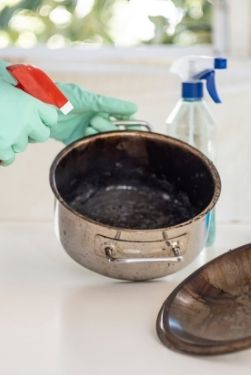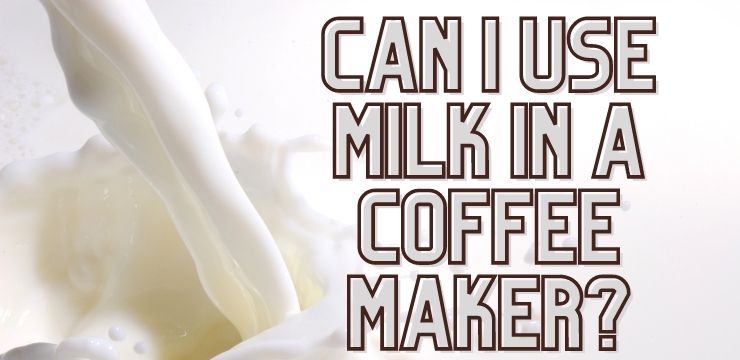A question that I am constantly being asked is whether you can make coffee with milk instead of water using a coffee machine or espresso machines at home? The answer is yes (if you have a coffee maker you don’t like much), but probably no (if you are sensible).
You can use milk in coffee makers in theory, but the question that really should be asked is why would you want to when you risk damaging the coffee maker?
Why It Is Not a Good Idea To Use Milk in a Coffee Maker
First, a little about the composition of milk. Milk is mostly water with all manner of fats and protein compounds suspended inside. As soon as you heat it significantly, the proteins begin to loosen from one another and eventually create a thicker mixture that can coat your machine’s internal components over time.
If you have ever left your stove on high heat with milk in the pan, eventually it reduces into an unrecognizable mass, you know what I’m talking about. The same thing happens when using milk in place of water in your coffeemaker…

Water is an excellent conductor of heat, and it brings out the flavor in coffee. However, many people like milk-based coffee instead of water for a creamier taste. This is the reason why people toy with the idea of using milk instead of water in a coffee maker.
Here are the important reasons why it is a bad idea to use milk in a coffee maker.
- The residue left behind by boiling milk on hot metal parts will build up and cause corrosion This will, in turn, lead to costly repairs down the road if you don’t unclog it regularly when needed or clean it thoroughly after each use with vinegar or other cleansers designed specifically for this purpose.
- If the coffee machine is not cleaned thoroughly after using milk in it, bacteria can cause your machine to become unsanitary.
- Over boiling milk leads to a rather disgusting taste.
But I Still Want To Use Milk In My Coffee Maker
I have warned you of the risks of using milk in your coffee maker but I guess you are determined. Okay here goes, but at your own risk.
First, you should use only cold milk and not boiling hot milk as this is the safest way to make a cup of coffee with milk in a coffee maker. You should also pour the milk in last so that it does not get heated excessively. Immediately after you pour the milk in, shut the coffee maker. Then add your ground coffee and water as usual.
Second, you should open the lid of the coffee maker and clean it as soon as possible. This will help remove any milk residue which could lead to a bad taste in future brews.
Finally, you should use your coffee machine frequently even with just water to help prevent excess buildup and corrosion.
All that said, I still strongly advise you not to use milk in your coffee maker!
Some Alternatives to Milk In Your Coffee Maker
I get it, you enjoy a creamy coffee beverage and you might think that milk in a coffee maker will give you the creamier coffee taste, right? But if you take a closer look, it won’t even produce the taste you are looking for.
Most coffee makers designed just for water will boil at around 212 degrees Fahrenheit and this cannot be changed. Creamy hot milk drinks need a much lower temperature to be optimal in flavor, so let’s look at some alternatives to putting milk in your precious espresso machines or coffee makers and avoid that bitter taste of over-boiled milk.
The first alternative to milk is just using what the machine was designed for. If you have a coffee maker made for just water, use that. You can make your brewed coffee just the way you like it and gently heat the milk in a pan on a stove. This will avoid bitter tasting coffee and gently steamed milk tastes a lot better also.
Another alternative is to buy a milk frother or steam wand, these are widely available in machines today and can even be used with the machine you already have. There are many milk frothers available to buy and my particular favorite is the EZ Basics Milk Frother.
Cleaning Your Coffee Maker After Using Milk in it
Hey, you put milk in your coffee maker for a creamier taste, huh? Well, it was a bad idea and now you have a big mess to clean up. I get it, you are going to feel bad about adding milk to your coffee maker and then not cleaning it properly–now what do you do? It’s not that difficult if you just follow these steps.
The first step is to unplug your coffee maker. This will help avoid electricity and water-related hazards.
Next, take a pot or a bucket of warm soapy water and carefully remove the milk residue from the accessible parts of the machine. Do this gently to ensure that you don’t damage the machine itself or break parts that will be harder to replace in the future.
After you have done this, use distilled white vinegar or any commercial coffee maker cleaner and carefully clean the coffee maker by running this solution through it to remove any residue that might be left behind in the machine. This should clear up any problems with damaged coffee makers or contaminated machines after using milk in them.
Thoroughly rinse the machine through with water afterward and then take yourself off to a quiet corner and have a long word with yourself to not do this again!
The Final Word On Using Milk Instead of Water In a Coffee Maker
Using milk in a coffee maker is not the best idea for two reasons. One, it will cause residue to form and this can be hard to clean out of your machine. Two, boiled milk contains bacteria which makes it potentially unsafe–especially if you have no intention of cleaning up after yourself! There are some alternatives that may work better for you like using water from the machine or buying a frother/steam wand instead. And finally, make sure to properly care for your device by following these steps: unplugging it; removing all remnants of milk; use distilled white vinegar or commercial cleaner on stubborn stains, and rinse thoroughly afterward.


